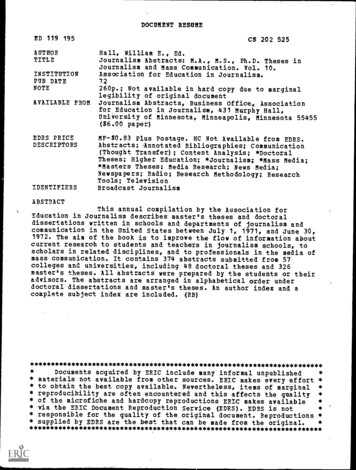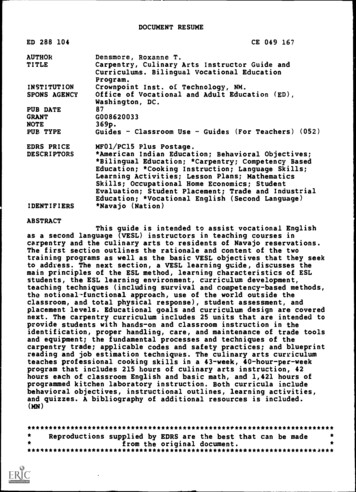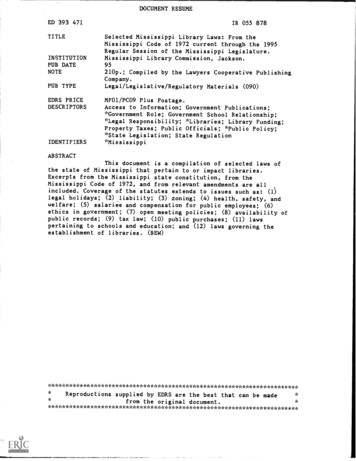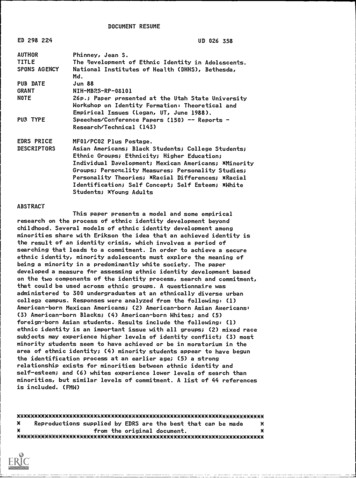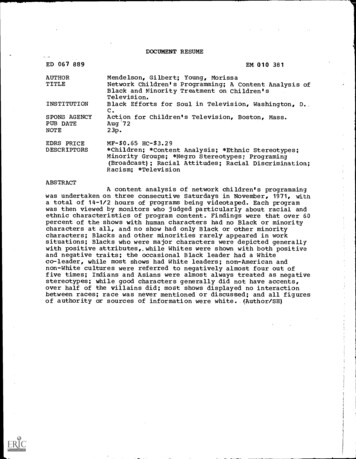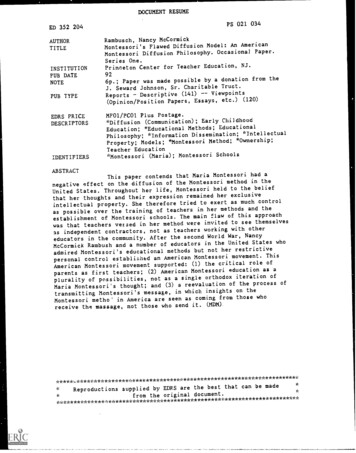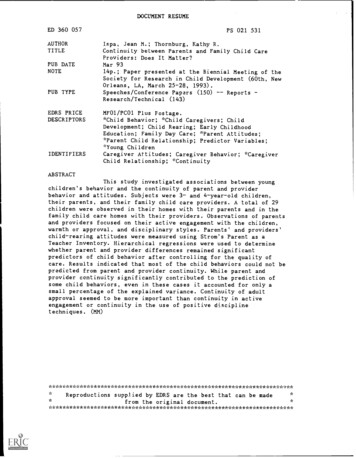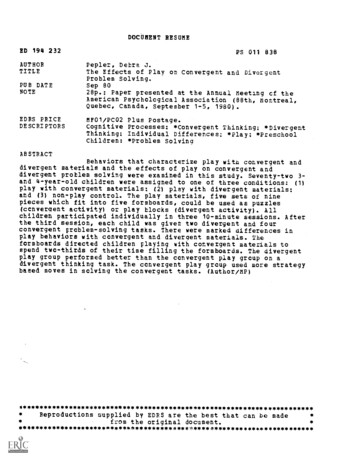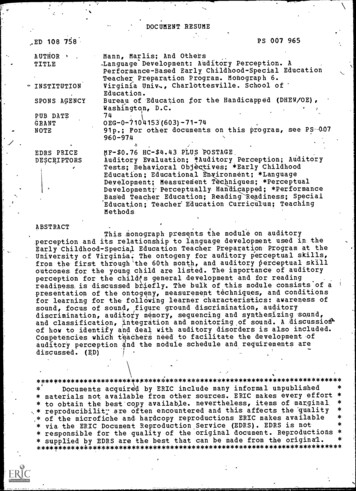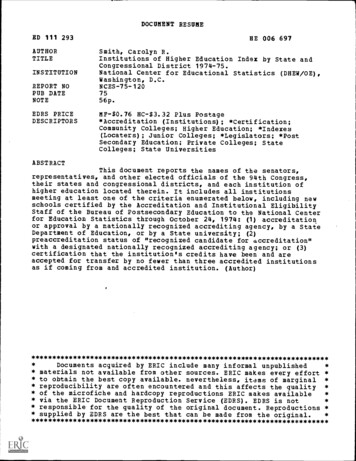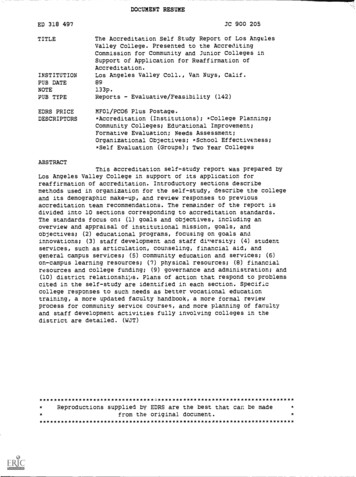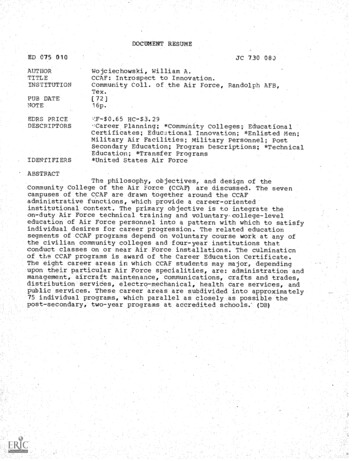
Transcription
DOCUMENT RESUMEED 075 010AUTHORTITLEINSTITUTIONJC 7.30 083Wojciechowski, William A.CCAF: Introspect to Innovation.Community Coll. of the Air Force, Randolph AFB,Tex.PUB DATENOTE[72]DRS PRICEDESCRIPTORS!,F- 0.65 HC - 3.29IDENTIFIERS16p.Career Planning; *CommUnity Colleges; EducationalCertificates; Educational Innovation; *Enlisted Men;Military Air Facilities; :Military Personnel; PostSecondary EducatiOn; Program Descriptions; *TechnicalEducation; *Transfer Programs*United States Air ForceABSTRACTThe philosophy, objectives, and design of theCommunity College of the Air Force (CCAF) are discussed. The sevencampuses of the CCAF are drawn together around the CCAFadministrative functions, which provide a career-orientedinstitutional context. The primary objective is to integrate theon -duty. Air Force technical training and voluntary college-leveleducation of Air Force personnel into a pattern with which to satisfyindividual desires for career progression. The related educationsegments of CCAF programs depend on voluntary course work at any ofthe civilian community colleges and four-year institutions thatconduct classes on or near Air Force installations. The culminaticnof the CCAF programs is award of the Career Education Certificate.The eight career areas in which CCAF students may major, dependingupon their particular Air Force specialities, are administration andmanagement, aircraft maintenance, communications, crafts and trades,distribution servides, electro-mechanical, health care services, andpublic services. These career areas are subdivided into approximately75 individual programs, which parallel as closely as possible thepost-secondary, two-year programs at accredited schools; (DB)
FILMED FROM BEST AVAILABLE COPYU.S. DEPARTMENT OF HEALTH.EDUCATION & WELFAREOFFICE OF EDUCATIONTHIS DOCUMENT HAS BEEN REPRODUCED EXACTLY AS RECEIVED FROMTHE PERSON OR ORGANIZATION ORIGIT POIDONTS OF VIEW OR OPNECESSARILYIN-4CCAF- INTRCSEECT TO INNOVATIONIMONSbyCDTATEDSATINGNOTREPRESENT OFFICIAL OFFICE OF EDUCATION POSITION OR POLICYCaptain William A. WojciechowskiEd. D.Plans Staff Officer1.(1N-C)Plans and Programs DivisionwCommunity Collage of the Air ForceABSTRACT"CCAF - Introspect to Innovation"serves asan introduction of the Community College ofthe Air Force concept to members,of thetechnical education community:The articleexplains the philosophy, objectives and designof CCAF as the Air Forces contribution to a"university without walls" concept ofcareereducation.UNIVERSITY OF CALIF.LOS ANGELESMNY5 1973CLEARINGHOUSE FORJUNIOR COLLEGEINFORMATION7",77:7777.
CCAF - INTROSPECT TO INNOVATIONThe Community College of the Air Force (CCAF), conceived in April1971 and born exactly one year later, is perhaps the most uniqueand innovative entry Into the family of community colleges spanningthe nation.Its organizational concept is novel, and the potentialstudent body consists of approximately 500,000 airmen of the UnitedStates Air Force.A multi-campus, trans-regional system with its'admlnistrative center at Randolph AFB, Texas (San Antonio), CCAF isthe educational manager of career education certificate programscarried out through existing, mutually affiliated schools of the;Air Training Command and the Air Force Security Service,This tech.-'nical education is combined with related education from cooperatingcommunity and junior 'colleges, four year colleges and universitiesto formji CCAF certifitate program.r i"The idea for a Community College of the Air Force was bOrn in .Air Training Command, but planners here (Randolph AFB) soon soughtthe counsel of two other'commanda - Air University and the Air?:Force Academy - bOth of which had extensive experience in higher ed7'Ucation and long association:with the civilian academic world,"T.:CorrellAT5TR;7170).Force," Air Forte Marazine,AssoCiatTsTE57p,':65CommunityTollege Of the AirMatch1.972(WashingtonC.1 Airlorce,1%.
Togetherthese three commands proposed the concept of careereducation for Air Force enlisted personnel to the Pentagon,where both the need for and value of a Community Co/lege forthe Air Force were quickly recognized.Active service in the U. S. Armed Forces had too long beenviewed as a 'three or four year void in a yoUng person's life.Countless attempts have been made by se,vicemen, with moderatesuccess, to obtain credit for their service connected educatiocalexperiences.A true career development pattern for enlistedpersonnel did not, exist prior to the CCAF concept.One Of the2pillars on which CCAF is built is the Utah Project.Since itwas demonstrated that Air Force courses could be taught in Utahoccupationally- oriented institution' at the post secondary andcollege level, CCAF planners pursued the idea of arranging totranscribe direct credit for these courses in the Air Forceschools.By using a semester-hour unit as the basic commondenominator, Air Force training could be combined with civilianinstitutional course work into a true career education pattern.2.Utah Project was carried out by the Air Force Association'sAerospace Foundation under a grant from the U. S. Office of.Education. Essentially, it makes certain Air Force technicalcurricula available to and adaptable for use by,,civiliah institutions.:. U OE Report No. 8-0301
ACCREDITATICN.Each of the seven campuses of the CCAFsystem has operated for years as a separately organized,independent school, providing technical training for AirForce job specialities.Togetherthe resources arecentrally controlled by the U. S. Air Force; howeverthe new, patterninthese institutions are drawn togetheraround the CCAF administrative functionscareer-oriented institutional context.which provide aThe SouthernAssociation's Cotmission on Occupational EducationInstitutiOns was receptive.to the proposal that Air Forcetechnical schoola becOme members of that association.TheSchool of Applied Aerospabe SCiences1 at Eheppard Air ForceBase, the School of Health Care Sciences, also at Sheppard,:,and' he Air Force schools at Keesler Air Force Ease,Iacnand.Air Force BaseTexas and Goodfellow/for membership.Each of these- schools was individually: rePreSented at theSotithern ASsociation'annUal convention in Niamilleadh,the,Commtinity College of theAir Force concept was briefed to the Executive Council ofthe Commission, and because of such factors as newness, size,and trans-regional organization, it was determined that theschools would seek accreditation on a one-at-a-time basis,3.O
after which the whole might be considered,On December 2,1971, each school was accepted as an affiliated member inthe Commission on Occupational Education Institutions ofthe Southern Association of Colleges and Schools,1972 each school was accredited for five years.On December 13,The two remainingschools of Applied Aerospace Sciences - Lowry AFT, Colorado and- located within the North CentralAssociation region were also accredited for five years at NorthCentralia annual meeting on March 28, 1973.Accreditationfosters beneficial access to Air Force curricula and methodsand the interchange of policy information between military andcivilian schOols.In factthe Curriculum Exchange Branch ofLiaison Division was established to.foster such ans primary, objective is to integrate theon-duty Air Force technical training and voluntary collegelevel education of Air Force personnel into a consistent,meaningful pattern to satisfy individual desires for careerprogression.The related education segments of CCAF programs
depend on voluntary course work at any of the several hundredcivilian community colleges and four year institutions whichconduct classes on or near Air ForCe installations.Usingthe Air. Force's'Education Services Program and the CCAFcareer education certificate patternal4ir Force enlistedpersonnel will haVe the opportunity to achieve worthwhilecareer educational objectives.Other CCAF objectives include:(1)Initiating accreditation and professional recognitionfor Air Force courses.(2)Documenting an individual's progress toward completionof his educational objectives via a central transcript serviceand authenticating official transcriFts-by the institutionalseal.(3) Analyzing Air Force curricula of the affiliated schoolsin terms of industrial and paraFrofessional associationstandards and civilian equiva]ency.(4)Developing and communicating to studentslocal education service officersthroughguidance toward education-al programs which simultaneously fulfill Air Force needs andmatch:Civilian requirements for credentials.The culminationof the CCAF programs is award of the Career Education Certificate.Realizing the importance of tying together these objectives5.
into a single vehicle of academic credibility, Air Forceleaders have specifically chartered CCAF with the responsibility to:"Provide a permanent, accredited in-stitutional context in which career education patterns may3be shaped and documented."Career Education Certificate.The structuring credentialof this effort to integrate Air Force technical trainingand voluntary education into a consistent, meaningfulpattern is the Career Education Certificate.The CertificateProgram consists of a minimum of 64 semester hours dividedamong the following:(1)Technical requirements consisting of a minimum of24 semester hours.In many instances, especially whererequired for association certificationmore will be re-quired.(2)Related Education requirements consisting of aminimum of 25 PPmster hoursrePresenting each Of thefolloWingareasCommunicatiVe Skills, Science, MathematicsHumanities; Social ScienceS and Physical Education.As before,specific requirements within theae areas may, also be set forth.3.ithLL.--TrairlinCollelation2-10, (Department of theAir Force;Headquarters Air Training Commaid, Randolph AFB,Texas);203 1972.6.
(3)Management and Military Science requirements con-sisting of a minimum of six semester hours.The total requirement varies depending on the complexity ofa particular career area.The model noted above is establish-ed as a minimal structure for all certificates awarded by theinstitution andis often exceeded by the requirements of aspecific career area program.Completion of a Career Education Certificate Program requiresprogression thrOugh five steps -- testing and enlistment inthe U. S. Air Force, admission, registration, advanceding and candidacy.tand-Testing and enlistment includes establish-ing eligibility for active service by meeting the requiredAir Force mental and physical standards.Technically, thetest battery serves as an entrance examination since thetests are standardized and validated as predictors of anindividual's ability and aptitude to benefit from certaintypes of Air Force Training.Assuming he is qualified for aparticular career area, a potential enlistee has cbnsiderablefreedom of choice:, like any other-student who seeks an edu.,ctitioto pursue the career of his choicedevelopedechnique js based oneompUteri:zedjorecests ofspeCialtyireqUireMents in military jobs, and ehangesconstant3-Yf!rich like 'theljobmarket in' the private sector.
'Admission is achieved through successful completion of BasicMilitary Training.Here a student is credited with four semesterhours, fulfilling the Physical Education, Health and First Aid'2 requirements common to all CCAF career programs, while he com-pletes processing tasks at, the USAF School of Military Sciences atLackland Air Force BaseTexas.,c.,jThe third step of the process is registration for a particularCCP Career program,studentRegistration occurs when the prospectivethroUgh his Education Services Officer, submits to CCAFan officiAlVtransCript or comparable documentatinn from an accreditedAlistitution.:containingTroof of satisfactory completion of a course-for courses Which may be used in CCAF career programs.CCA,Utran-scripts are automatically generated when individuals complete courses,at any of the affiliated technical schools,For-theseindiyidualswho do not attend Air,Forde technical schoolst enter Vprentice training programsa CCAF transcript is generated:after a CCAF Careers Division eValUationofthe courses documentedthe transcrtptHfroOnether:institution, as arra0g4 by the EducationServices Officer On the' base wherejthepprenticeship occurs.
The final steps progressing toward achievement of, the CareerEducation Certificate are Advanced Standing and Candidacy.Advanced Standing is indicated when a student has completed45 semester houfs of his CCAF career program.Candidacyoccurs when a student has been certified by his EducationServices Officer as having completed all requirements of hisCareer Education Certificate program.At this pointsome-thing should be said about the role of the EducationalServices Officer.By virtue of his educational guidance andcounseling training and role, the Education Services Officerperforms functions analogous to a student's academic advisorin a civilian institution.Upon receipt of the Education Services Officer's recommendationfor candidacythe CCAF Careers Division evaluates in detailthe student's. total edUeationaI:experiences.'A recommendationis made to the Policy Council, chaired by the Yice7Fresidentof the College.The Policy Council reviews the recommendationand assures that all requirements have been:JheCareer EducationCertifiCate is signed andrwarded to theindividual:by:the Regiettar, thus completing the iroceas.In its entirety, the Career Education Certificate Programconsists of eight career areas in which CCAF students maymajor depending upon their particular Air FOrce specialties.
Administration and ManagementAircraft MaintenancsCommunicationsCrafts and TradesDistribution ServicesZlectrO-MechanicalHealth Care SciencesServicesThese career areas are further subdivided into approximately75 individual programs, which are not only associated withan Air force specialty but parallel, as closely as possible,the postsecondary two -year programs at accredited schoolsacross the nationsIn this connectionit, is interesting tonote that approximately 902 of the Alr Force specialties havedirect equivalents in civilian occupations.made to incorporateEfforts are beingederil and state licensing and para-professional certifying requirements, wherimer possible, intothe design of these:,ProgramsAn example is certification ofCCAF.!s LaT4Enforcement program by the Texas Law EnforcementAgency,Career growth has: always been a genuine concern of Air Forceraanners.CCAF administrators are convinced that the CareerEducation Certificate programs will stimulate AA increase in10
voluntary education enrollments with civilian inatitutions.To this end, the CCAF programs reiresent a combination ofAir Force teChnical trainingcivilian technical educationand related education :whiCh', togetherreflect the autonomous,pluralistic system of education in the United States.AN INSTITUTICNAL CUEXT.CCAF's mission directive which, ineffect, has similar impact to a chartertration with providing "a permanentcharges its adminis-accredited institutionalcontext" for the career education needs of Air lorce perscnnel.This task is to be accomplished by utilizing, in new patternswherever possibleexisting systems, facilities and materialresources.The Schools of Applied Aerospace SciencesCare Sciencesand the Air Force Securityvide the accreditable base from which to create a single incontext.poseTheirs Is a comm. philosePhy-bf Fur-previringindividuals to enter Air Force specialties.However, each,school retains its institutional identityWrithin:this philosophical bond through a series of, parallel objectives,each atti:med:Ito' its own needs, each managing,/ its reeources,;each accomplishing its part of the overall Air Force mission.Individually, they are schools; tegether:they serve the,needsof the Air Force Community as the Community College, of theAir Force,11.
The hniqueneaS of CCAF lies in the fact that it is a multi,pus, trans-regional institution, composed of affiliateddchoolsp with a separate but'd ltinct central administrativeunit.This adMinistratiVe Unit, located at Randolph Air ForceBase, Texas, accomplishes the 'objectives previously discussed,and houses the. integrated group of technical speCialists andArAcurriculum analysts which is the Careers Division.Responsib-ility for planning, building and directing the career education.programs of the student body lies here.At this point, delineatien of curricula and program is necessaryto add clarification to the CCAF'insiitutional context,R.The.technical curriculum is determined principally by ihe needs ofthe Air Force,These needs are communicated to the schools bya programming unit separate from the CCAF system.Of the 300,000instructional hours in the System, some 15,000 each year, arereplaced by new materials, in responsechanging missions of thnAir Force. ,ThilsAir Force are satisfied.changing technology andthe needs of theHowever, this iconstantlyshiftingcurriculum is analyzed by CCAF in terms familiar to civilianinstitutions, blended with technical recidilrements for'CCAF career programs, and combined with 41untary course work12
at civilian4nstitutions in an accredited institutionalcontextAdministrative theorists will recognize thiS.pattern' of management, which:Corson refers to as the principalof dualism,e.9 parallel power structures,that parallel power structures have always existed and mustexist in the administrative structure of higher education4institutions,The patterns of delegation of authority arenot consistent froM one institution 'to anotheri;Corsonrecommends that a distinction be drawn between academic andother functions, delineating officials responsible for each.'This distinction is drawn in the CCAF pattern,emerging as the academic entity in this parallel structure.AN EMERGING INSTITUTION,Force is now a reality.The Community'College of the AirIts student body is the Air Forcesactive duty enlisted popglation,' Students receive programguidance and documentation, i.e.,,catalogs outling'ceriificationrequirements,:and transcript service from the CCAF's centraladministrative unit at Randolph AFBTexas.Partial studentaid' in the form, of tuition assistance :fOr-voluntary courseA,49, John. J. Corson,,Governance of Colleges and Universities,New York' McGraw-Hilt Book'Co., Inc., 196013
work at civilian institutions is handled through the AirForce's Edncation Services Program at the student's homebase, where other necessary student personnel servicesalso available.The initial transcript system became operational in November 1972,ancUis serving enlisted personnel who completed resident technicalschool courses after JanuaryA professional staff of approximately 70 military and civilianeducators have joined the college administration, and areevaluating Air Force training programs for credit and applicabilityto civilian certifyinge licensing standardIn the'long run, CCAF planners are confident that this newinstitution will be the catalyst for a bar:ic 'change in internal'and external perceptions of an Air Force career, underliningthe real quality of the U. -S. Air Force technical training. CCAFplanners further agreed it will contribute to a flexible, qualityforce capable ofulfilling peacetime missions and respondingquickly, if required, to wartime cOntingencieS.P14
Individuals who do not:choose the, U. S. Air Force as acareer but exit service after a few years, will take withthem CCAF doCumentation as evidence that rEiservice enlistmentis not necessarilyiltime out" of a:young citizen's, life.TheHCCAFIls curriculum exChinge:function (making Air Fotceszterial:aVailable at cost to Civilian educators)and thereturn to:civilian life of individuals having CCAFdocumen,tation for placement in college programs or in business andindUntry allows-the Air Force to be responsive in its roleasnational resource."The, importanceof degreeslicenses,certificates and other symbols of qualification in todayes:society cannot be overemphasized,;called a certificated meritocracy'The world of wo
segments of CCAF programs depend on voluntary course work at any of the civilian community colleges and four-year institutions that conduct classes on or near Air Force installations. The culminaticn of the CCAF programs is award of the Career Education Certificate. The eight career areas in
